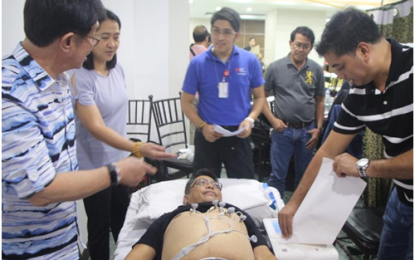
HEALTH WORKERS. Department of Health (DOH) Calabarzon Regional Director Dr. Eduardo C. Janairo (left) spearheads the training of government health workers in Calabarzon on the operation of Electrocardiogram (ECG) and Ultrasound machines at Eurotel Hotel, Quezon City on Oct. 9 to 10 and Oct. 20-18. (Photo courtesy of DOH4A-MRCU)
CALAMBA CITY, Laguna – Around 80 government health workers from the Calabarzon provinces of Cavite, Laguna, Batangas, Rizal and Quezon started Tuesday their two-day training on Electrocardiogram (ECG) and Ultrasound operations at the Eurotel Hotel, Quezon City from Oct. 9 to 10.
The Department of Health (DOH) Calabarzon Regional Office spearheaded the training for participants comprised of city and municipal health officers, nurses and non-communicable disease coordinators of selected municipalities and cities in the region.
“This training will provide health workers the competency on ECG and ultrasound operation and interpretation which they will use and integrate during health care delivery,” DOH Calabarzon regional director Dr. Eduardo C. Janairo said
The health workers were trained in selected facilities, which received ECG machines with analyzer, ultrasound scanner with probe and Doppler under the DOH's Health Facility Enhancement Program (HFEP).
“It is very important that our health workers know how to accurately diagnose and assess test results from these machines to be able to present proper treatment for early prevention of diseases,” Janairo said.
The DOH regional recipients of the equipment include Cavite with 27 ECG Machines with analyzer; Laguna - four ECG machines with analyzer; Batangas - five ECG machines with analyzer and six ultrasound scanners with V probe and Doppler; Rizal - four ultrasound scanners with V probe and Doppler; and Quezon - one ECG machine with analyzer.
The DOH Calabarzon regional director said that of the nearly 800 rural health units in the Calabarzon, around 60 percent has ECG and ultrasound machines.
However, around 90 percent of the health workers serving these rural health units still lack the know-how to use the equipment.
“That is why we have to build up the competencies of health workers in these health facilities to maximize their potentials from ECG and ultrasound expertise because later on we will install digital x-ray machines in all these RHUs,” Janairo said.
The health workers undertook operation of the electrocardiogram (ECG or EKG) as a diagnostic tool used to assess the electrical and muscular functions of the heart.
The electrodes that were placed on the chest walls detect electrical impulses that are generated by the heart. These are interpreted by a physician who can learn the heart rate and rhythm, as well as blood flow to the ventricles
Ultrasound imaging or scanning also known as sonography, involves the use of smaller transducer (probe) and ultrasound gel placed directly on the skin.
High frequency sound waves are transmitted from the probe through the gel into the body. The probe then collects the sounds that bounce back and a computer translate them into an image.
“We will continue to improve health care delivery in the community by providing essential equipment and trainings including applications in diagnosis and management and make them accessible to rural health areas of country,” Janairo said. (PNA)
